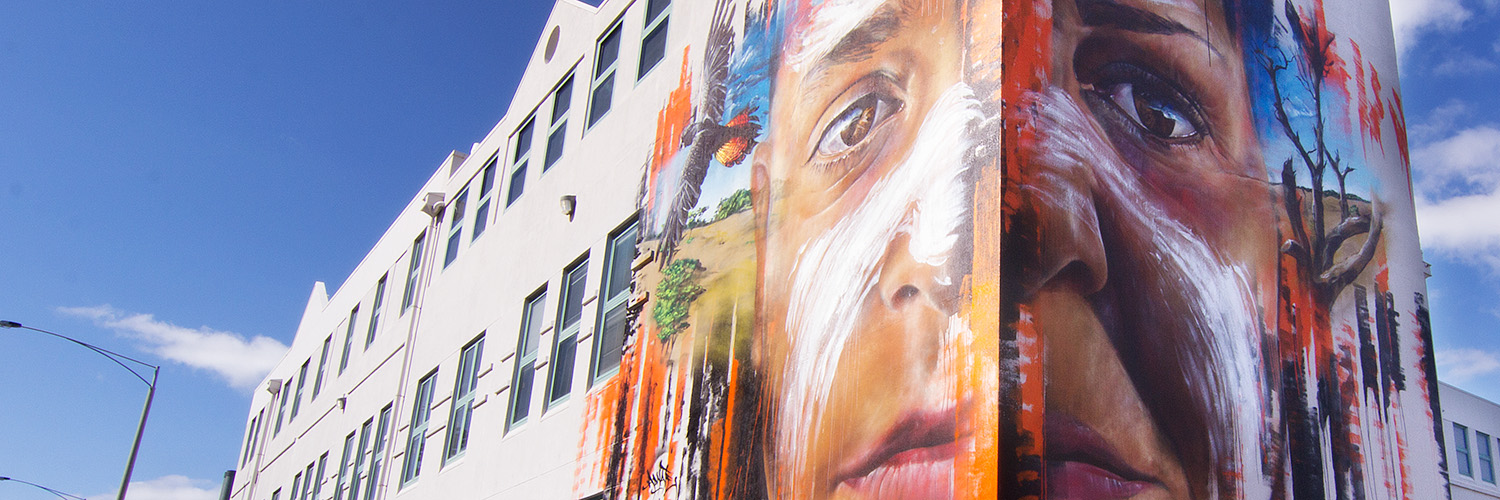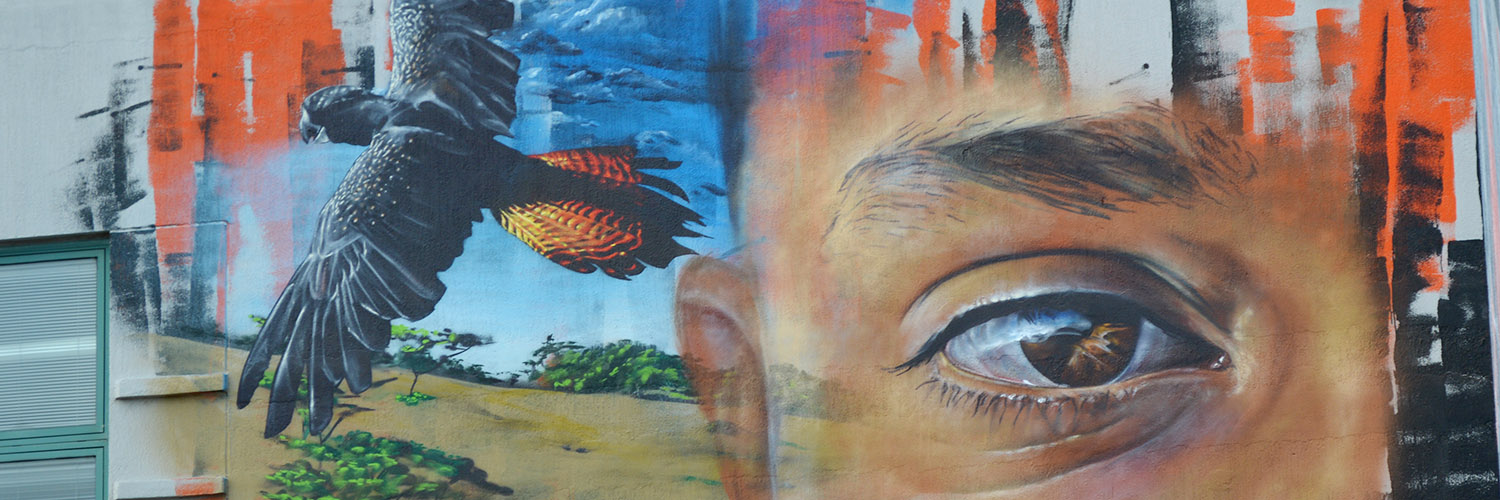Preserve Past Embrace Tomorrow
The Ngatanwarr Mural was painted by world renowned artist ‘Adnate’ (www.adnate.com.au) on the corner of Merri and Kepler Street, Warrnambool March 13th-16th, 2015. The mural incorporates information detailing significant cultural sites and narratives of the Gunditjmara and Great South Coast region.
The project has been led by a steering group consisting of Leadership Great South Coast, Warrnambool Art Gallery, the F Project, Gunditjmara Aboriginal Cooperative and South West TAFE.
The project aligns with the Great South Coast Group’s goal to ‘better integrate nature based and indigenous tourism products into state, national and international marketing structures’ and the goal of ‘building rural communities sense of place through investment in community arts projects’.
Funding for the mural has been made possible through seed funding from the Hugh Williamson Foundation (Bug Blitz ) and through contributions from the State Government (Anti-Graffiti funds), Gunditjmara Aboriginal Cooperative and the ‘Isobel & David Jones Family Foundation’ .
The Artist
Adnate is an artist that realizes his portraits in spray paint. He has moved past his roots in graffiti, utilizing the medium to carry his realist style into the fine art realm.
Heavily influenced by the chiaroscuro of renaissance like Carvaggio, Adnate embraces portraiture like the masters of the XXI century.
Elevating graffiti art above the level of letter writing, Adnates subject matter and their subsequent status often belies the intent of his portraits.
His works are often cropped by evocative slices of vibrant colour, chanelling a presence of character, much like a still life uses it’s background as a setting for detail and showing of fine bushstrokes. Adnates realism is highlighted by the use of what appears careless, but is frequently calculated blocks of vibrant color.
Adnates work can be seen in Barcelona, Berlin, Mumbai, New York, Paris, Sydney and Melbourne.
www.adnate.com.au
The Stories. The Places
Gunditjmara
The Gunditjmara are an Indigenous Australian group from western Victoria (Gunditj = belonging to, mara = person). Their neighbors to the west were the Buandig people, to the north the Jardwadjali and Djab wurrung peoples, and in the east the Girai wurrung people
http://en.wikipedia.org/wiki/Gunditjmara
The Gunditjmara Land Justice Story
The Gunditjmara Land Justice Story tells the story of two important events from recent decades; the precedence of the ground-breaking Onus (and Frankland) vs. Alcoa case before the High Court of Australia in the early 1980s and the Gunditjmara native title consent determination by the Federal Court of Australia in 2007.
http://www.aiatsis.gov.au/_files/ntru/publications/monographs/MonographGunditjmara.pdf
Eumerella Wars
The Eumeralla wars are a notable conflict of the 1840s between European settlers and the traditional Gunditjmara indigenous inhabitants of the land surrounding the Eumerella river.
http://www.smh.com.au/national/a-forgotten-war-a-haunted-land-20130809-2rnc9.html
Framlingham Aboriginal Reserve
Framlingham is an Aboriginal reserve established by the Board for the Protection of Aborigines in Victoria, Australia in 1861. It is located beside the Hopkins River 15 kilometers north of Warrnambool.
http://en.wikipedia.org/wiki/Framlingham,_Victoria
Tower Hill Wildlife Reserve & Worn Gundidj Visitor Centre
Tower Hill, just to the west of Warrnambool, is one of the most fascinating geological formations in Victoria. It has an important place in local Aboriginal history and teems with wildlife.
http://visitwarrnambool.com.au/things-to-do/tower-hill/
Moyjil Aboriginal Place (Point Ritchie)
The archaeological remains found at Point Ritchie (Moyjil Aboriginal Place) contain evidence of Aboriginal life and are amongst the most fragile of cultural remains found on the Victorian Aboriginal Cultural Heritage Register. The remains, known as shell middens, provide key historical evidence of Aboriginal cultural heritage.
Budj Bim National Heritage Landscape
The name Budj Bim has been given to two areas on the Australian National Heritage List, proclaimed in 2004, the Budj Bim National Heritage Landscape - Tyrendarra Area and the Budj Bim National Heritage Landscape - Mount Eccles Lake Condah Area.
http://www.budjbimtours.com/
Lake Condah Indigenous Protected Area
Lake Condah Indigenous Protected Area is made up of 1,700 hectares of significant wetlands and stony rises right next to the historic lava flows of Mount Eccles National Park in south-west Victoria. The area is part of the Budj Bim National Heritage Landscape listed in 2004. Lake Condah was included in the listing because of its outstanding cultural heritage value for all Australians
http://www.environment.gov.au/indigenous/ipa/declared/lake-condah.html
Tyrendarra Indigenous Protected Area
The ancient volcanic landscape of Tyrendarra was created by the spectacular eruption of Budj Bim (Mount Eccles) around 27,000 years ago. This region is a traditional meeting place and camping area for the Gunditjmara people - the land is part of major Dreaming trails and an important ceremonial site.
http://www.environment.gov.au/indigenous/ipa/declared/tyrendarra.html
Deen Maar Indigenous Protected Area
Deen Maar lies on the south-west cost of Victoria, near the community of Yambuk. The property is four and half square kilometres of rolling sand dunes, limestone ridges, river, lake and wetlands, located in the South East Coastal Plain bioregion.
http://www.environment.gov.au/indigenous/ipa/declared/deen-maar.html
Disclaimer
The Ngatanwarr Mural Steering Group acknowledges the valuable contribution of South West TAFE in making this prominent mural space available. The Ngatanwarr Mural Steering Group also acknowledges that the mural is a temporary addition to the building and that at any time South West TAFE may choose to either, remove, replace, or repair the mural.

